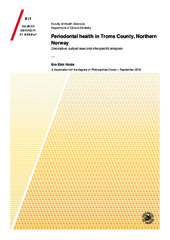Periodontal health in Troms County, Northern Norway. Descriptive, subject level and site-specific analyses
Permanent link
https://hdl.handle.net/10037/16302Date
2019-09-20Type
Doctoral thesisDoktorgradsavhandling
Author
Holde, Gro EirinAbstract
Background/Aim - Periodontal disease is one of the most prevalent diseases in the world. There is a scarcity of epidemiological studies of periodontal disease in Norway. The overall aim of this thesis was to assess the burden of periodontitis in an adult population, and to explore risk factors, as well as health-promoting factors related to the disease.
Methods - The thesis is based on a cross-sectional study of an adult population (20-79 years old). Data were collected between October 2013 and November 2014 in Troms County, Northern Norway. Information about sociodemographic characteristics, behavioral factors, oral health-related quality of life, and sense of coherence was collected by self-reported questionnaire. Periodontal probing depth, bleeding on probing and presence of plaque were assessed for all teeth. Radiographic bone loss was examined using orthopantomograms.
Results - Half of participants had periodontitis (CDC/AAP case definition), of which 9% had severe periodontitis. Periodontitis prevalence increased markedly with age, was higher among men, and positively associated with smoking, lower levels of education, and lower income. Using Andersen’s behavioral model of health services use, more social structure and stronger SOC was related to enabling resources, which in turn was associated with more use of dental services. More use of dental services was related to more periodontitis and more periodontitis was associated with increased oral health impacts. Gingival bleeding was affected by local, behavioral and socioeconomic factors. Smoking reduced the general bleeding tendency of the gingiva and attenuated the response to supragingival plaque.
Conclusions - There is a high burden of periodontitis among adults in Troms County. Socioeconomic factors and smoking were main predictors of periodontitis. Smoking strongly affected the clinical expression of gingivitis. There is a complex relationship between population characteristics, use of dental services and oral health outcomes. Regular dental visiting habits did not reduce the likelihood of periodontitis.
Has part(s)
Paper I: Holde, G.E., Oscarson, N., Trovik, T.A., Tillberg, A. & Jönsson, B. (2017). Periodontitis Prevalence and Severity in Adults: A Cross-Sectional Study in Norwegian Circumpolar Communities. Journal of Periodontology, 88(10), 1012-1022. Also available at https://doi.org/10.1902/jop.2017.170164. Accepted manuscript version available in Munin at https://hdl.handle.net/10037/16323.
Paper II: Holde, G.E., Baker, S.R. & Jönsson, B. (2018). Periodontitis and quality of life: What is the role of socioeconomic status, sense of coherence, dental service use and oral health practices? An exploratory theory-guided analysis on a Norwegian population. Journal of Clinical Periodontology, 45(7), 768-779. Also available at https://doi.org/10.1111/jcpe.12906. Accepted manuscript version available in Munin at https://hdl.handle.net/10037/14823.
Paper III: Holde, G.E., Jönsson, B., Oscarson, N. & Müller H.P. To what extent does smoking affect gingival bleeding response to supragingival plaque? (Submitted Manuscript). Published version in Journal of Periodontal Research, 2019, available in Munin at https://hdl.handle.net/10037/16912.
Related research data
Tromstannen - Oral Health in Northern NorwayPublisher
UiT The Arctic University of NorwayUiT Norges arktiske universitet
Metadata
Show full item recordCollections
The following license file are associated with this item:


 English
English norsk
norsk
